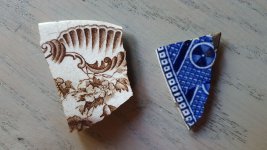HI-McDunnogh
Full Member
I've got an old home site on my property that has been a long labor of love. It is absolutely surrounded/inundated by forged square shank nails, so detecting anything non-ferrous has been almost impossible. I've taken to slowly shoveling and sifting which has yielded better results, but is a slow arduous process. To the post...
I found both of these examples of what I believe to be plates while sifting the other day. Is anyone able to place a name, manufacturer, and/or date to either of the two styles?
Thanks as always!
I found both of these examples of what I believe to be plates while sifting the other day. Is anyone able to place a name, manufacturer, and/or date to either of the two styles?
Thanks as always!
Attachments
Last edited:






